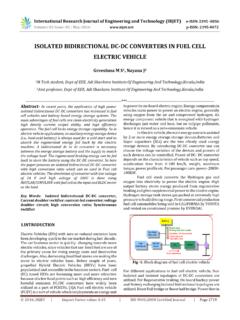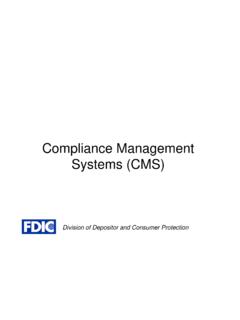Transcription of POWER LOAD MANAGEMENT Techniques and Methods in …
1 International Research Journal of Engineering and Technology (IRJET) e-ISSN: 2395-0056 Volume: 02 Issue: 09 | Dec-2015 p-ISSN: 2395-0072 2015, IRJET ISO 9001:2008 Certified Journal Page 2459 POWER LOAD MANAGEMENT Techniques and Methods in Electric POWER System Montaser .Atta . kassem1 , Abdelfatah Ali Elahwil2 1 Department of Electrical Engineering ,Higher Institute of Inclusive Professional - ,ben Walid, Libya 2 Department of Electrical Engineering ,Higher Institute of Inclusive Professional - ,ben Walid, Libya ---------------------------------------- -----------------------------**--------- ---------------------------------------- --------------------Abstract : The growth in the demand for electricity in Libya during the last decade witnessed a dramatic growth in the national's annual residential development has played a major role in boosting the demand for electric POWER .
2 The domestic sector in Libya already accounts for approximately 39 percent of electricity demand. To meet the projected demand for electrical POWER to cope with, the development plans, increases in the population and the rising in the living standards, government will have to accomplish new POWER generating units. Comparing with the high budget of constructing new generating POWER units, load MANAGEMENT system it would be attractive resource that should be seriously considered as an important part of national energy program, where demand growth rate exceeds the supply since it is playing an increasing role around the world as a valuable and cost-effective energy resource. Hence, was light projecting on POWER load MANAGEMENT program, for its benefit in reducing the energy demand at peak time.
3 Key Words: Load MANAGEMENT , Maximum Demand, Demand Factor, Tariffs, Peak Demand Valley Filling, Load Shifting ,Load Reduction. 1. INTRODUCTION Electricity is characterized by the fact that its production and consumption act nearly at the same time. Furthermore electricity cannot be stored in large quantities. This means that POWER generation must match demand alteration, whereas demand is affected by climate, economic growth and customers' consumption patterns. These factors make the demand to fluctuate at different time. Utility must invest in the generation plant and equipment to keep enough net peaking capability according to the system maximum demand. If the utilities do not impose any system measures, there will be a serious imbalance in POWER supply and demand.
4 Excessive or insufficient investment will lead to idle asset or create POWER shortage problems that will be uncomfortable to both suppliers and customers. The system is referred to the Demand Side MANAGEMENT . Demand side MANAGEMENT is the effective, efficient and economic use of energy by an organization. It relates to all forms of energy; electricity, gas, solar, diesel, petrol etc. The researcher will concentrate only on electrical energy. Demand side MANAGEMENT is a method of containing and reducing the overall cost of energy. By establishing a demand side MANAGEMENT program, an organization should aim to conserve all forms of energy by eliminating waste and encouraging the efficient use of energy. The financial benefits of a successful demand side MANAGEMENT can be quite large.
5 Energy is one of the factors of production over which a company has some control and soundly based demand side MANAGEMENT program is a means of reducing operating costs, increasing profits and remaining competitive. In non-profit organization such as government utilities, hospital and university, demand side MANAGEMENT can be a way to stretch a very limited budget. Will look through this study at how demand side MANAGEMENT applies to raise POWER operation efficiency, to minimize the cost of electricity and as well as maintaining the comfortable level of working and studying atmosphere, especially based on the following points: 1. Annual electricity demand hit the growth rate over the past ten years because of the rapid growth and increasing of total number of buildings.
6 International Research Journal of Engineering and Technology (IRJET) e-ISSN: 2395-0056 Volume: 02 Issue: 09 | Dec-2015 p-ISSN: 2395-0072 2015, IRJET ISO 9001:2008 Certified Journal Page 2460 2. The changes of rate of electricity cost (Peak time operation costs triple of low peaks operation). 2. CONCEPT OF POWER LOAD MANAGEMENT The load MANAGEMENT is a new concept of distribution of electricity aiming at a more efficacious supply network system. Such a control system should satisfy the needs of consumers at the lowest possible peak loading. There is a strong upward tendency in using load MANAGEMENT throughout the world.
7 The direct load MANAGEMENT systems have passed through the experimental stage and have been now adapted as an everyday practice is a great many of supply network systems. The economic grounds for introduction of these systems have been justified throughout the world and also certain. The load MANAGEMENT is a process going along with electricity conservation which decreases total electricity consumption, while the load MANAGEMENT is intended for consumption control over a certain period of time . Load MANAGEMENT is defined as sets of objectives designed to control and modifies the patterns of demands of various consumers of a POWER utility. This control and modification enables the supply system to meet the demand at all times in most economic manner.
8 DEFINITION FOR POWER SYSTEM EVALUATION In order to understand the concept of load MANAGEMENT clearly, some basic definitions in electric POWER systems are discussed .Connected load is the rating (in kW) of the apparatus installed on consumer premises .Maximum demand is the maximum load (in MW), which a consumer uses at any time .Demand factor is the ratio of the connected load to maximum demand . 4. POWER LOAD MANAGEMENT SUPPLY AND DEMAND Load MANAGEMENT does not aim to decrease the overall electricity consumption, rather approaches (or replies to) the consumption pattern. It could be applied both on energy demand and on supply sides: Supply-Side Load MANAGEMENT This MANAGEMENT is defined as the measure, which is taken at the supply side to meet the demand.
9 The concept has been very popular in the seventies of the twentieth century. If the society demanded more POWER , the POWER companies would simply find a way to supply users even by building more generation facilities. This was the essence of the concept. Demand-Side Of POWER Load MANAGEMENT This MANAGEMENT describes the planning and implementation of activities designed to influence customers in such a way that the shape of the POWER load curve of the utility can be modified to produce POWER in an optimal way. Peak clipping and load shifting from peak to off-peak period s Techniques are used to achieve these purposes. Demand side load MANAGEMENT includes not only technical or economic but social measures as well, since it is directly related to the behavioral issues.
10 5. Techniques OF POWER LOAD MANAGEMENT The selection of the load shape objective is determined by the number of the supply side constraints. Some of these constraints may be whether the system is energy constrained, reliability of the system, the need for schedule maintenance and the state of distribution and transmission system. There are three basics types of load shape changes: Peak Clipping: Peak clipping means reduction load during peak period to get the load profile as desired by the utility. This voltage reduction on the part of consumers is directly controlled by the utility and is usually enforced at peak time s When usage of electric appliances by consumers is at its maximum .The shape of load profile through the peak clipping technique is shown in figure (2).













